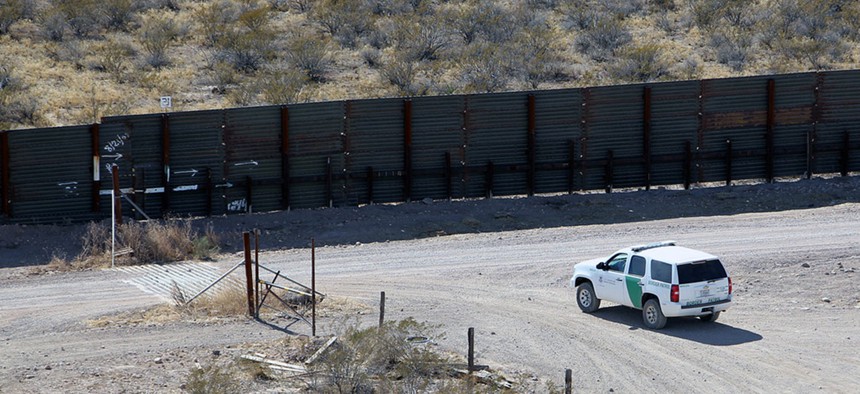
A Border Patrol vehicle secures border fence line in Arizona in 2011. Customs and Border Protection file photo
Analysis: How Trump Is Upending the Conventional Wisdom on Illegal Immigration
The president has been frustrated on many fronts in his first hundred days, but on his watch, unauthorized border crossings have fallen sharply.
Obamacare remains the law of the land. So does NAFTA. Tax reform exists only as pixels in a tweet. Infrastructure ain’t happening. Five months after the Republicans won united control of Congress and the presidency, it seems uncertain whether one-party Washington can avoid a government shutdown over a budget dispute.
Yet as Day 100 of his presidency nears, President Donald Trump can take credit for one huge accomplishment, an accomplishment more central to his election campaign than any of the unfulfilled pledges above. Illegal immigration into the United States has slowed dramatically. The Department of Homeland Security reports that illegal crossings across the southern border plunged 40 percent in the first month of the Trump presidency, the steepest decline in illegal migration since the recession of 2009. Illegal immigration by family groups with children has dropped by over 90 percent.
This accomplishment may or may not prove enduring. It was not brought about by any decisive policy change. Trump’s wall is not funded. No new enforcement measures have been put in place. People eligible for President Obama’s delayed action continue to receive work authorization. While arrests of illegal aliens inside the country have accelerated under Trump, actual deportations are running at a slower pace than in the first quarter of 2016. Orders to ban travel from some Muslim-majority countries were widely publicized, but quickly halted by the courts—and in any case, do not seem very relevant to overwhelmingly Catholic Latin America.
This spring’s immigration turnabout was unexpected, to put it mildly, by most participants in the immigration debate. For years, the predominant view has been that migration flows—legal or not—are powered by deep tidal currents beyond the control of mere human governments.
In the summer of 2014, tens of thousands of minors from Central America surged across the southern border. Some few suggested that these immigrants were responding to the incentive offered by Obama’s policy of deferred action for border crossers who arrived under age 18. That view was widely derided as insensitive and uninformed. The young Central Americans had not been “pulled” by U.S. policy; they had been “pushed” 2,200-miles north, across Guatemala and through a dozen Mexican states, by gang violence in their native countries.
So, too, with the mass migration across the western Mediterranean into Italy and via Turkey into southeastern Europe, and then onward to Germany, Sweden, and the United Kingdom. Migrants moved to richer countries because they felt they must, not because they perceived they could. Restrictions were not only inhumane, but futile.
"Flows of Mexican migrants to the United States have been driven since our grandparents’ day by the supply and demand for work on either side of the border, regardless of walls and other obstacles thrown in their way.” So wrote The New York Times’ Eduardo Porter in October 2016, summarizing a bipartisan report by leading figures in the immigration field. He spoke for the consensus. Economic incentives mattered. Legal disincentives did not.
This spring those former certainties suddenly look very wrong. If rude words by the head of government, an inconsistent uptick in interior enforcement, plus a travel ban that flunked judicial review, suffice to cut illegal migration flows by 60 to 90 percent, then the policies and attitudes of the receiving countries begin to look powerful indeed.
Perhaps the Trump effect will prove short-lived. If the economy continues to expand, perhaps illegal migration will resume. But the first quarter of 2017 revealed what is possible. The perception of stricter enforcement can change behavior. That discovery points the way to the next possible accomplishment: building a structure of enforcement that can endure past the first hundred days.
About 1 million unauthorized Mexican immigrants have returned home since 2007. It probably will not be easy to reduce the population of unauthorized Mexican immigrants much more. (About three-quarters of the remaining illegal immigrants have been present in the United States for 10 years or more, according to the Pew survey.) But about half the population of unauthorized immigrants in the United States comes from places other than Mexico, and they are much less long-settled. The perception of more rigorous enforcement may induce more of them to return home, too.
The work of Harvard’s George Borjas suggests that unskilled immigration depresses the wages of unskilled natives and enriches skilled natives by increasing their purchasing power. Skilled immigration has the opposite effect. (Borjas’s findings are contested, but compelling.) It’s not coincidence that countries that favor skilled immigration, like Canada and Australia, have seen slower trends toward wage inequality than countries that favor unskilled immigration, like the United States or Sweden. (Since 1980, Sweden has experienced the most extreme swing toward income inequality of all developed nations. Sweden’s immigration intake actually exceeds that of the United States: About one-fifth of Swedes are either foreign-born themselves, or born to two parents from outside Sweden. In large part because of the country’s huge intake of refugees, especially from the Middle East and Africa, Swedish immigration skews even more unskilled than America’s.)
With that framework in mind, the United States needs to think hard about the kind of immigration policy that makes sense for a country facing persistent stagnation of non-college wages—and on the verge of a robotics revolution that will in fairly short order make obsolete millions of jobs now held by the less skilled: cashiers, truck drivers, fast food workers, and so on. Senators Tom Cotton and David Perdue that would reduce the absolute level of legal immigration by about half, back to the levels prevailing before 1991, while holding steady the number of visas for skilled workers—effectively tilting the composition of future flows toward the college-educated.
Passing laws through Congress has not exactly been a point of strength of the Trump administration to date. Nor has the administration shown much interest in thinking systematically about reforms that might actually help the hard-pressed voters who made the difference in the industrial Midwest. But somebody should be thinking about it. Better enforcement joined to enactment of the Cotton-Perdue immigration bill might give an embattled administration and an endangered Republican Congress at least one achievement that might impress somebody other than former senior managers at Goldman Sachs.
Had borders been protected better before, there would be no Trump and LePen now. Demagogues demagogue by talking about issues people care about. The New Deal and the postwar European welfare states were built in great part to beat back the threat of communism—to prove that liberal governments could better meet the grievances the communists exploited. In our time, we now again face an extremist challenge, this time from authoritarian populists on both sides of the Atlantic. Immigration beyond society’s capacity to absorb and assimilate has provided those extremists with their most potent source of strength. Why let them keep it?







